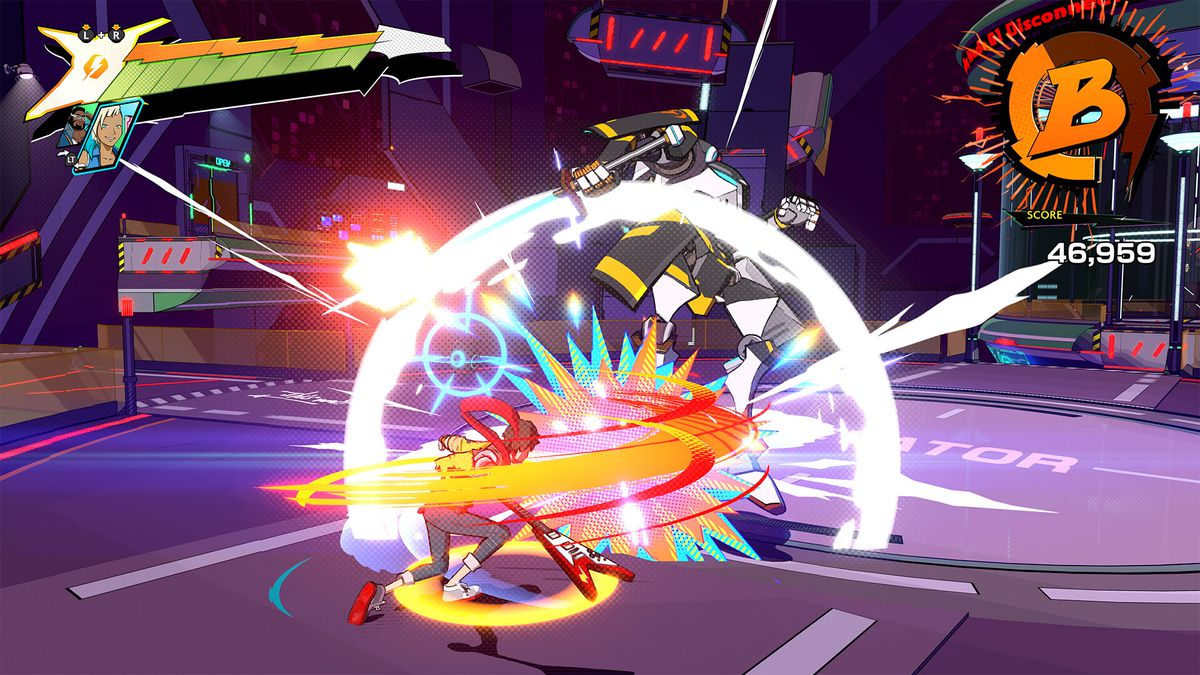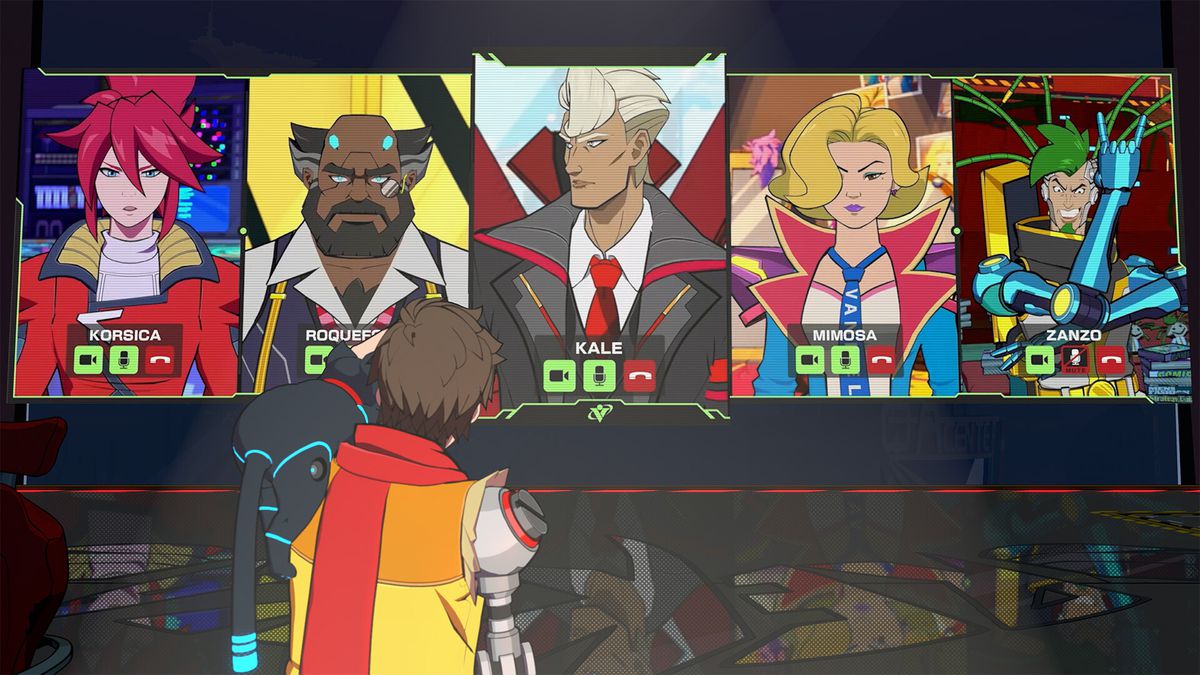My entire life, I have experienced one crucial block to fully enjoying rhythm games: I have no rhythm. That hasn’t stopped me from giving it the old college try, though. For years, I’ve suffered through subpar Guitar Hero performances and B-rank scores on Dance Dance Revolution games. Enter Hi-Fi Rush, a game that blends the hacking and slashing of a 3D action game with rhythmic fighting. Hi-Fi Rush is fun regardless of how attuned your internal metronome is. I sat down with Hi-Fi Rush director John Johanas to ask him: Just exactly how do you make a rhythm game for those who have no rhythm?
Johanas told me that the team at Tango Gameworks always imagined Hi-Fi Rush as a rhythm game. In the game, you play as Chai, a plucky young man who dreams of becoming a rock star. After a lab accident, he gets an iPod implanted in his chest, and he becomes attuned to the beat of the world around him. It’s up to Chai to fight his way out of the surrounding world of Vandelay Technologies. As he hacks and slashes, the fights pulse to the beat of rock tracks from artists like Nine Inch Nails, The Black Keys, and The Prodigy.
When I asked Johanas how the idea came to be, he said, “Surprisingly, it was relatively unchanged from the original pitch. And while a lot of the team members were like, Is this really going to work? they were supportive in at least giving it a try.”

The challenge became how to blend the two genres — rhythm game and action-adventure — and keep it playable. “The first thing that we did was make a system where no matter what you did, everything would sync up so it would land on the beat,” Johanas said. From there, the team implemented a system where failing to hit everything perfectly wouldn’t punish you — even if you don’t time your attacks correctly, Chai will still perform the movements to the beat — but landing hits to the beat of the song gives you an extra bonus.
“You’re not restricted by the music, you know, you can do whatever you want. You can do whatever combos you want,” he said. “The enemies will move just like a regular game. It’s just that everything is synced like a music video.”
The developers were careful in the way they implemented the rhythm mechanics. The game contains a little visualizer that very clearly shows the beat if you are having trouble tuning into a specific song. The game’s world is also full of other visual cues, like the puffing steam around Chai or the pace he snaps his fingers.
As development progressed, the team ended up cutting certain features for the sake of keeping it simple and playable. In Hi-Fi Rush, you can call in partners who will come into the field and attack enemies for you. While in development, the team tested out a feature where you could completely change characters in the middle of battle and play the game on a different rhythm.

“No one could get it because it was so complicated to switch from one character who had a certain rhythm style to another one, like on the fly with the chaos of battle. So we’re like, OK, we’re gonna make this as simple as possible. So now it’s literally one button that you don’t have to worry about the timing of calling in your partners, they’ll do it for you.”
Hi-Fi Rush isn’t just an approachable rhythm game. Tango Gameworks also made a great entry point for those looking to try out the 3D action genre. The moment you jump into a game like say, Bayonetta, you get a relatively large repertoire of combos to practice. In Hi-Fi Rush, the game walks you through beat by beat, button by button.
“The game was made with accessibility in mind, with the idea that these are normally genres that people tend to turn away from, because it’s not their type of genre, and we wanted to make something that was accessible and fun, and that even people who have difficulty with [it] can probably play to the end.”
- SEO Powered Content & PR Distribution. Get Amplified Today.
- Platoblockchain. Web3 Metaverse Intelligence. Knowledge Amplified. Access Here.
- Source: https://www.polygon.com/gaming/23594230/hi-fi-rush-interview-rhythm-game-development
- 3d
- a
- About
- accessibility
- accessible
- accident
- Action
- After
- always
- and
- Another
- around
- Artists
- attack
- Attacks
- Battle
- because
- becomes
- becoming
- Black
- Blend
- Block
- Bonus
- button
- call
- calling
- careful
- certain
- challenge
- change
- Chaos
- character
- characters
- chatting
- clearly
- College
- come
- completely
- complicated
- contains
- could
- crucial
- cutting
- dance
- developers
- Development
- DID
- different
- Difficulty
- Director
- Dont
- down
- dreams
- enemies
- Enter
- Entire
- entry
- Ether (ETH)
- Even
- everything
- exactly
- experienced
- extra
- Feature
- Features
- field
- fight
- fighting
- fights
- First
- from
- full
- fully
- fun
- game
- Games
- get
- gives
- Giving
- going
- great
- hacking
- hacks
- having
- Hero
- Hit
- Hits
- How
- How To
- HTTPS
- idea
- image
- implemented
- in
- internal
- iPod
- IT
- John
- jump
- Keep
- keeping
- keys
- Know
- lab
- Land
- landing
- large
- Life
- little
- looking
- Lot
- made
- make
- man
- Matter
- mechanics
- Members
- Middle
- mind
- moment
- move
- movements
- Music
- normally
- Old
- ONE
- original
- Other
- Pace
- partners
- People
- perform
- performances
- Pitch
- plato
- Plato Data Intelligence
- PlatoData
- Play
- Point
- practice
- probably
- progressed
- pulse
- Regardless
- regular
- relatively
- restricted
- Rock
- rush
- Said
- sake
- several
- Shows
- Simple
- slashing
- So
- something
- specific
- Star
- Steam
- Still
- stopped
- style
- supportive
- Surrounding
- Switch
- system
- team
- Technologies
- The
- the world
- their
- thing
- Through
- time
- timing
- to
- trouble
- TURN
- via
- Video
- wanted
- webp
- What
- while
- WHO
- will
- Work
- world
- would
- years
- young
- Your
- zephyrnet









